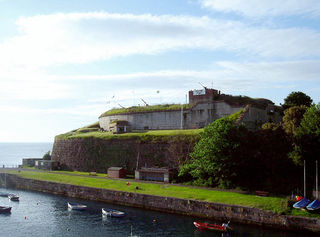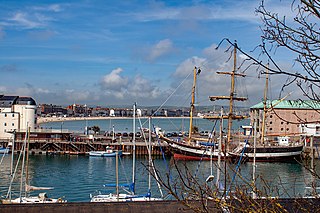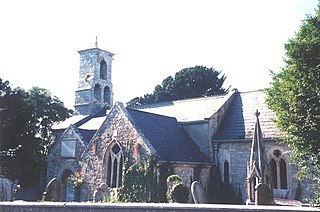
The Isle of Portland is a tied island, 6 kilometres (4 mi) long by 2.7 kilometres (1.7 mi) wide, in the English Channel. The southern tip, Portland Bill, lies 8 kilometres (5 mi) south of the resort of Weymouth, forming the southernmost point of the county of Dorset, England. A barrier beach called Chesil Beach joins Portland with mainland England. The A354 road passes down the Portland end of the beach and then over the Fleet Lagoon by bridge to the mainland. The population of Portland is 13,417.

Weymouth and Portland was a local government district with borough status in Dorset, England from 1974 to 2019. It consisted of the resort of Weymouth and the Isle of Portland, and includes the areas of Wyke Regis, Preston, Melcombe Regis, Upwey, Broadwey, Southill, Nottington, Westham, Radipole, Chiswell, Castletown, Fortuneswell, Weston, Southwell and Easton; the latter six being on the Isle of Portland.

Nothe Fort is a fort in Weymouth, Dorset, England, situated at the end of the Nothe Peninsula, which juts eastwards from the town of Weymouth, and Weymouth Harbour, into the sea to the north of the ex-military Portland Harbour. The fort is located next to Nothe Gardens.

Sandsfoot Castle, also known historically as Weymouth Castle, is an artillery fort constructed by Henry VIII near Weymouth, Dorset. It formed part of the King's Device programme to protect against invasion from France and the Holy Roman Empire, and defended the Weymouth Bay anchorage. The stone castle had an octagonal gun platform, linked to a residential blockhouse, and was completed by 1542 at a cost of £3,887. Earthwork defences were built around the landward side of the castle, probably in 1623. Sandsfoot saw service during the English Civil War, when it was held by Parliament and Royalists in turn during the conflict. It survived the interregnum but, following Charles II's restoration to the throne, the fortress was withdrawn from military use in 1665.

Wyke Regis is a village in the civil parish of Weymouth, in south Dorset, England. The village is part of the south western suburbs of Weymouth, on the northern shore of Portland Harbour and the south-eastern end of Chesil Beach. Wyke is 15 kilometres (9 mi) south of the county town, Dorchester. The village has a population of around 5,500.

Sir Thomas Fowell Buxton, 1st Baronet Buxton of Belfield and Runton, was an English Member of Parliament, brewer, abolitionist and social reformer. He married Hannah Gurney, whose sister became Elizabeth Fry, and became a great friend of her father Joseph Gurney and the extended Gurney family.

Weymouth is a sea-side town and civil parish in the Dorset district, in the ceremonial county of Dorset, on the English Channel coast of England. Situated on a sheltered bay at the mouth of the River Wey, 7 miles (11 km) south of the county town of Dorchester, Weymouth had a population of 53,427 in 2021. It is the third-largest settlement in Dorset after Bournemouth and Poole. The greater Weymouth urban area has a population of 72,802.

Ferry Bridge is at the beginning of the causeway to the Isle of Portland, Dorset, England, and is the point at which the Fleet lagoon joins Portland Harbour. It is situated several hundred metres south of Portland's boundary with the village of Wyke Regis, Weymouth. To the west of Ferry Bridge is the start of The Fleet, which is an internationally important nature reserve that extends to Abbotsbury Swannery, while to the east is Portland Harbour. Along the harbour side is Smallmouth Beach. The only road between Portland and the Mainland passes across Ferry Bridge.

All Saints Church is a Church of England church in Easton, on the Isle of Portland, Dorset. It was consecrated in 1917 and has been a listed grade II building since September 1978. The church succeeded to the rights, privileges, registers and silver of the St George's Church. It has been described as the finest ecclesiastical building on Portland – though somewhat hidden at its position. The church remains active to date, as part of the Portland Parish – a host of three churches; St. John's Church, All Saints Church and the Avalanche Memorial Church.

St. John's Church is an Anglican Church of England church in Fortuneswell, on the Isle of Portland, Dorset. It was built between 1838–40 and has been a Listed Grade II building since January 1951. The churchyard walls, gate piers, railings, and steps of St. John's Church, dating from 1839–40, became Grade II Listed in September 1978. At this same time, two headstone monuments, about 5 metres north east from the west tower of the church became Grade II Listed.

Nothe Parade is a waterfront street on the south side of Weymouth Harbour in the seaside town of Weymouth, Dorset, southern England. The waterfront dates from the 17th-century, but most of the cottages in Nothe Parade date from the 19th century. Nothe Parade was formerly known as Nothe Walk before it was developed.

Holy Trinity Church is a Church of England church in Weymouth, Dorset, England. Built of Portland stone in 1834–36, and extended and re-oriented in 1886–87, the church is a Grade II* listed building. Designed by Philip Wyatt, it has been described as being of "intrinsic architectural interest", having an "unusual scheme of development" and "occupying a significant position on the axis of Weymouth's Town Bridge".

All Saints Church is a Church of England church of 15th-century origin in Wyke Regis, Weymouth, Dorset, England. Built largely of Portland stone, the Royal Commission on the Historical Monuments of England have described the church as a "remarkably consistent and unchanged 15th-century design". It has been a Grade I listed building since 1953. Facing Wyke Road from the modern cemetery opposite the church is the Wyke Regis War Memorial, erected in 1919.

St Mary's Church is a Church of England parish church in Weymouth, Dorset, England. Built of Portland stone in 1815–1817, the church has been described as having an "austere design in Palladian mode". It has been a Grade I listed building since 1953.

Stone Pier, also known as South Pier, is a pier located on the southern side of the entrance of Weymouth Harbour, in Dorset, England. It extends out from the Nothe Peninsula, which is the location of the Nothe Fort and Nothe Gardens.

Alexandra Gardens Theatre was a theatre at Weymouth, Dorset, England. Originally known as the Alexandra Gardens Concert Hall, it was opened in 1924 and later converted into an amusement arcade in 1963. The building was destroyed by fire in 1993 and replaced with a new building which is still in use as the Electric Palace Amusement Arcade.

The Jubilee Clock Tower is a free-standing clock tower on the Esplanade of Weymouth, Dorset, England. It was built and erected in 1888 to commemorate the 1887 Golden Jubilee of Queen Victoria and became Grade II Listed in 1974. Historic England described the clock as being a "florid but characteristic enrichment to the sea-front" and "boldy coloured". It is built of cast and wrought-iron and set on a Portland stone base.

St Nicholas' Church is a Church of England church in Broadwey, Dorset, England. It has Norman origins, but most of the existing church dates from 19th century work. St Nicholas' was the parish church of Broadwey until 1933 when the village became a suburb of Weymouth.

St Laurence's Church is a Church of England parish church in Upwey, Dorset, England. Much of the existing church dates to the late 15th century, with some earlier fabric and later additions of the 19th and 20th centuries. It is a Grade II* listed building.

St Ann's Church is a Church of England parish church in Radipole, Weymouth, Dorset, England. The church dates to the 13th century, with later additions, and is a Grade II* listed building. Both the boundary wall of the churchyard and church room opposite are also Grade II listed.



















